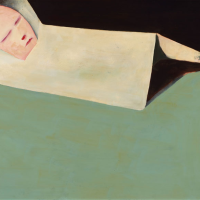76. CHARLES BLACKMAN

Charles Blackman held his first art exhibition at his Hawthorn studio in February 1952. The paintings depicted the uniformed schoolgirls he saw in the surrounding suburban streets. This beginning gave rise to major recognition of his now legendary Schoolgirls series. By the end of the following year, he had completed five further exhibitions in Melbourne, two in Sydney and one in Adelaide. The respected Melbourne critic, Alan McCulloch (1907-1992), predicted Blackmans success from the beginning: the curiously evocative quality of nearly all Blackmans painting could easily carry this artist on to a very special place in the Australian art of our time.1
After the success of his Schoolgirls exhibitions of 1952 and 1953, Blackman found himself at the centre of the argument between traditional and modern art. Melbourne of the early 1950s largely endorsed Prime Minister Robert Menzies ambition to have a conservative Australian Academy of Art. Being ensnared in the wider public scrutiny of modern art would have undoubtedly taken a toll. However, instead of deterring him, it encouraged Blackman to further solidify his trademark style.
Sleeping Figure comes from this crucial period directly between Blackmans Schoolgirls paintings of 1951-54, and his Alice in Wonderland series of 1956. The painting is typical of this transitionary period characterised by muted colours and simplified figures placed in large flat planes. In Sleeping Figure these elements are effortlessly executed; the figure is suspended in calm repose at the top of the two-toned background, one foot anchored where the colours meet. A similar sleeping subject reappears in The Room (The Blue Dress) of the same year 1954, which is held in the collection of the National Gallery of Australia (Figure 1). The two paintings also bear stylistic similarities in their flattened forms and the blanched, unsmiling faces that are emblematic of this period.
Upon viewing the Sleeping Figure c1954 the artists son, Auguste Blackman, remarked that it was a key painting in the development of [Blackmans] individual voice in the artscape of the time It shows the confidence of a young artist striking out amongst his peers.2 Arising from the midway point in this important period, Blackmans Sleeping Figure represents the artist as a pioneering young creative.
Footnotes:
1. McCulloch, A., Meanjin, Melbourne, May 1952, quoted in Shapcott, T., The Art of Charles Blackman, Andre Deutsch, London, 1989, p.9
2. Auguste Blackman in email correspondence with the author, 5 October 2022
Asta Cameron